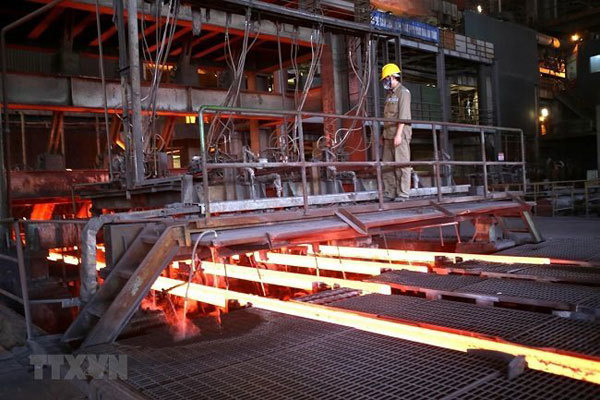 |
| A worker at a steel production line owned by Hoa Phat Hai Duong Steel JSC. The Government has ordered stabilizing the prices of steel. – Photo: VNA |
Hoa Phat Group on May 8 increased its steel prices drastically, with CB240 rolled steel and D10 CB300 steel exceeding VND17,300 per kilogram.
The Thai Nguyen Iron and Steel Company’s prices of these two steel products are also higher than VND17,000 per kilogram.
The steel price hike has made life difficult for enterprises and contractors. Many contractors have had to walk away from projects. For example, Long Giang Company has declined at least two construction projects since early this year due to obvious losses, a deputy general director of the company said.
Therefore, Deputy PM Khai, at a recent meeting on the regulation of prices for the remaining months of the year, also asked the Ministry of Industry and Trade to work out solutions to balance the steel supply in the domestic market and steel exports, the local media reported.
The Vietnam Steel Association (VSA) also asked its members to raise the steel production capacity. In the first four months of the year, the raw steel volume picked up 17.4%, while the rolled steel volume surged nearly 62%.
VSA also asked its members to restructure their distribution systems to stabilize local supplies and meet the market demand. Enterprises should reduce production costs and ensure appropriate selling prices of steel to stabilize them.
As for materials for production, the association required enterprises to prioritize local materials instead of imports. VSA forecast that the demand for steel this month would remain high but the competition among steel producers would be fiercer.
The steel selling prices will continue rising as the material prices in the global market remain high, while supplies from China and India could fall.
Earlier, the Vietnam Industry Agency under the Ministry of Industry and Trade attributed the steel price spike to the high prices of imported materials for steel production. In addition, the longer shipping time triggered by Covid-19 has contributed to the hike.
Moreover, China’s demand for steel has increased sharply after the pandemic. Its economy is recovering and economic development is being encouraged by investing in infrastructure. In 2020, it imported 38.56 million tons of steel, increasing 150% over the previous year.
This year, Vietnam will have to import more than 18 million tons of iron ore and 6-6.5 million tons of scrap steel.
Steelmakers reported higher steel volumes and sales in the first quarter of this year. According to VSA, they produced 7.66 million tons of steel and sold 6.78 million tons of steel products, up 33.8% and 35%, respectively, over the same period last year.
Meanwhile, steel exports soared 59.5% to 1.63 million tons.
Many experts predicted the demand for steel products would grow 3%-5% this year as the real estate and construction sectors are resuming operations and major infrastructure projects such as the Long Thanh International Airport and the North-South Expressway are underway.
SGT

The paradox of construction material market
Authorities need to clarify the situation in which construction contractors are complaining because construction material prices are fluctuating, with an increase of 40% upwards, while many building material manufacturers earn huge profits.